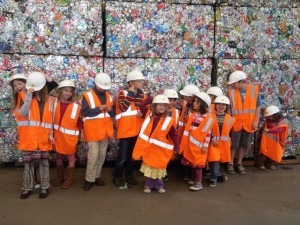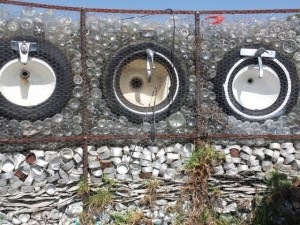Last week I went on a fieldtrip with our homeschool group that was a real eye opener. I’d always been told that taking your kids on a fieldtrip to the dump is a great experience, and now I know why.
To set the stage, I should describe our family’s relationship to garbage: We are, I would guess, on the more vigilant side when it comes to recycling. We recycle everything that we can, and try to keep up with what our garbage collection facility will take. We are careful to dispose of potentially hazardous waste, like batteries and used electronics, in the best manner. When we go shopping for food, I point out to the kids when something they want to buy is overpackaged in a wasteful way.
I would say, however, that I’m a bigger fan of reusing and using renewable resources than recycling. Although some recycling makes a lot of sense, we could make even bigger changes that would have a much more beneficial effect on the world. In our family, we buy a lot of what we eat in bulk using reusable containers. We started using reusable grocery bags years ago, before our local bag laws were even being debated. It took a little bit of forced reprogramming, because I kept forgetting the bags that I was keeping in the car, but at this point, grabbing bags on the way into a store is so second-nature I don’t even think about it. I even buy clothing and hardware with reusable bags.
But despite the preceding two paragraphs, I’ve always known that my family could do better. I have never entertained the idea of living completely waste-free as some friends of mine are attempting, but I have watched our habits and considered what we how we could improve what we’re doing.

Here’s where a trip to the dump—or rather, as they call it, “the recovery facility”—came in.
Workers at the dump no longer see their job as hiding away society’s garbage. Our guide was first in line to show us that. We met in a nice, clean building surrounded by pleasant gardens which included a demonstration composter. She showed the kids various types of “garbage” and explained whether they could be reused, recycled, or just thrown away. Her big displays were a huge pile of the ubiquitous single-use plastic shopping bag, a bin of different recyclable and non-recyclable containers, and an aluminum water canteen.
Our kids are generally a tough crowd when it comes to teaching this stuff—they already knew what everything was and some even debated why one type of item was recyclable in their district when it wasn’t in another. So the real learning came in when we donned our hard hats and orange vests and trouped into the recycling facility.
Many things could have hit me as impressive, but here are the big things I learned:
First of all, when you throw stuff in your recycling bin, it doesn’t just go off into machines and magically turn into a new bottle, some toilet paper, or playground matting. Actual individual people get their [gloved] hands on a lot all of it. Our recycling starts by getting dumped by the truck into a huge pile, then it gets pushed by a person driving a frontloader, machine-sorted with magnets, jigglers, and blowers, and then finds its way back to humans again for the final sort. I was very conscious as I watched these hard-working people sorting our crap of whether my actions were making this job any harder. And I had to admit that they were.
We commit various recycling faux pas:
I will admit that I don’t always check whether our garbage collection service actually takes some of the things I throw in the recycling. I know that everyone in my family has been guilty of the “it’s better to put it in if you think they might be able to use it” mentality. Well, no, it’s not better to put it in. The people working at the facility have two major jobs: One is making sure that the machines did their job, grabbing various items out of the stream that should have been sorted before. The other is to separate out the things that machines have no concept of: garbage that has made its way into the recycling stream. So first of all, I have made a pledge to myself to check when we have a question about whether our facility can handle something. (And often, if your facility can’t use it you can drop it by a facility like Grey Bears sometime when you’re passing by and they can take it.)
I asked our guide about cleaning out containers. I’ve heard conflicting reports about whether containers in the recycling bin should be clean or not. She said that they prefer that people rinse them, because they have problems with vermin that just love the last of our spaghetti sauce or yogurt. However, since most of us are using pure drinking water for everything from cooking to washing our cars, this is actually not a great use of water in areas prone to drought. People who have done the analysis say that it’s really best in places where water is scarce not to rinse them, since the final destination facility will be using grey water for that purpose. However, I do know that I can do a better job of striking a balance. My biggest fault is in not doing the dirty

work when I find a container in the back of the fridge half filled with moldy something-or-another. More often than I should admit to, I put the whole container, moldy stuff and all, into the recycling. But I am now going to remind myself that I’m making my problem someone else’s problem, and I’ll be scraping out those yucky containers.
Two small bad habits: I tend to screw metal jar tops back on because of the smell factor. But when the recycling facility gets a glass jar with a metal or plastic top, someone has to deal with that. And although I know that containers made of different materials should be broken apart, I don’t always do that. But if the recovery facility gets a paperboard container with an aluminum bottom glued on, it will probably have to go in the landfill.
As we walked up the road, past sculptures made by UCSC students (see photo) and to the top of the landfill, our guide told us a recycling success story. Twenty years ago, this landfill was given 50 years before it would be exhausted. Today, they still are predicting 50 years, all due to diverting recyclables from the landfill. Off in the distance, she pointed to the most successful part of the recycling effort: a mountain of yard waste slowly composting itself into the beautiful, rich soil that built our county’s huge agricultural business.
Two thumbs up for taking this fieldtrip with your kids. It’s important that we not push important issues like where our garbage goes aside. All of us share the responsibility of making our community healthy for now and for the future.



We took this trip, too. As well as one to the dump. Definitely an eye opener! Great for me and for the kids to really see what happens to all our trash/recycling.